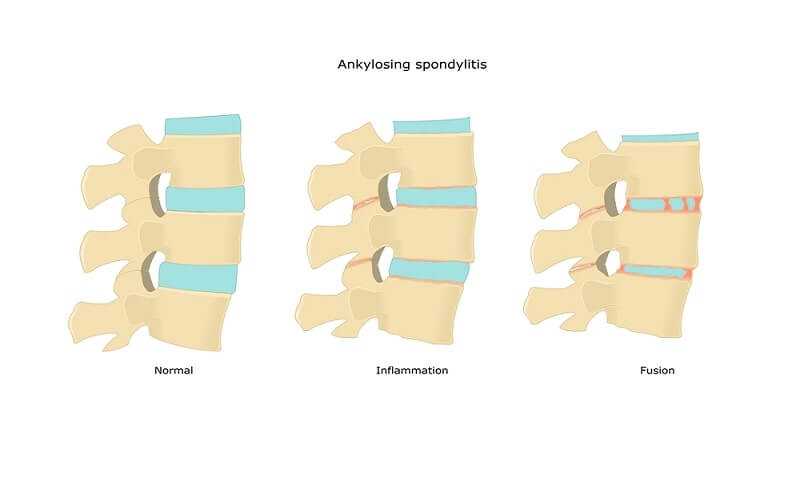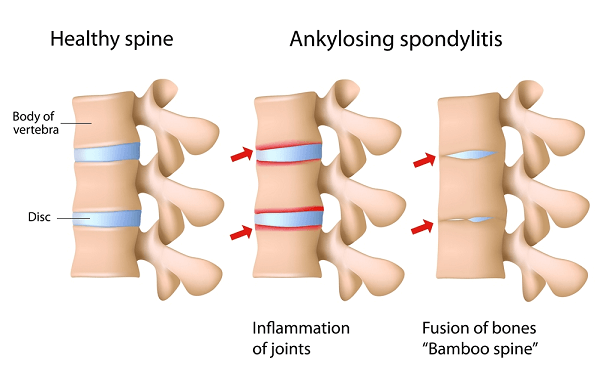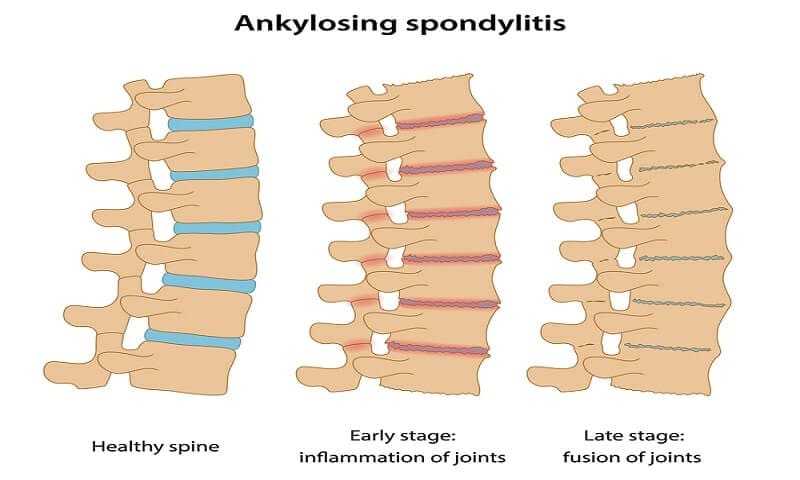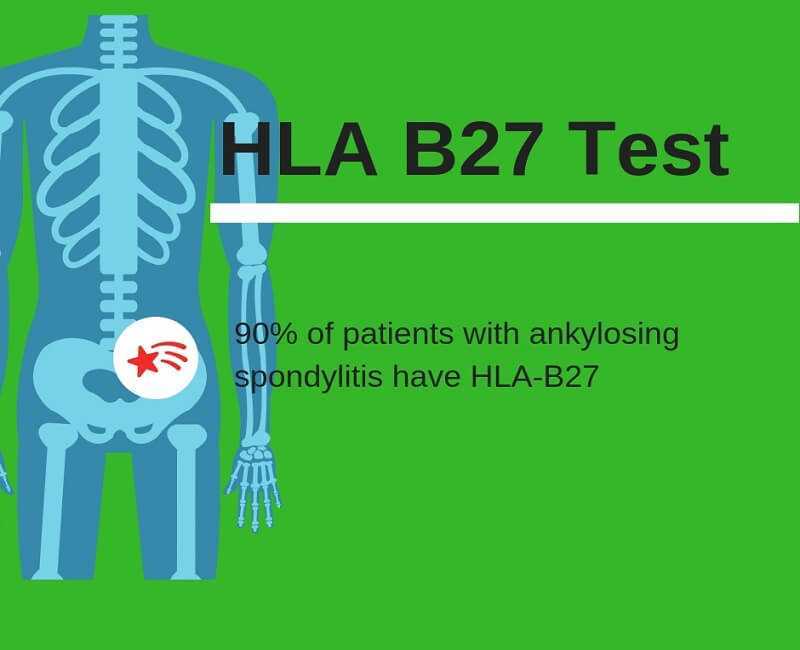About Ankylosing Spondylitis

Robert Van Dyck is an urbane and witty man in his late forties, with friendly brown eyes and a boyish thatch of brown hair. He stands and walks, however, as he puts it, “half like an ape,” with his spine perpetually stiff and hunched over and his head tilted forward so he faces the ground. To look a visitor in the eye, he must roll his eyes upward and peer over the top of his glasses. He eases himself into a chair, bending only at the hips, and demonstrates that he can turn his head from side to side no more than half an inch.

Robert is the victim of the third form of arthritis that can affect the spine: ankylosing spondylitis, a disease also often called stiff spine, frozen spine, poker spine, ankylosing spondylarthrosis and Marie-Strumpell disease (after two nineteenth-century physicians who studied it). It is far less common than either degenerative or rheumatoid arthritis, affecting about two out of every thousand people. In contrast to rheumatoid arthritis, it strikes men more than twice as often as women.
Ankylosing spondylitis typically begins when a person is in his or her twenties (Robert Van Dyck was in college when he learned he had the disease) as pain and stiffness in the lower back that may persist over a period of months or years. The inflammatory process usually starts in the base of the spine and the sacroiliac joints and over a period of years slowly, insidiously moves up the spinal column. It attacks the intervertebral discs in particular, destroying the fibrocartilage and replacing it with scar tissue that gradually ossifies (turns to bone), thus fusing the vertebrae together into a solid, rigid rod. In the illustration opposite, the enlarged “window” into the man’s spine shows six vertebrae that thus have been fused by ossified discs into a single, stiff structure. (The word “ankylosing” means fusing, and “spondylitis” means inflammation of the vertebra.)

The final outcome of the disease is quite variable and unpredictable. While Robert’s spine is totally fused from top to bottom, sometimes the disease will fuse just a few of the lower lumbar vertebrae, leaving the person aware only of some stiffness. Other times it will hunch a person over until he or she is almost unable to see ahead, as shown in the illustration on the opposite page. And the disease may also attack the hips and shoulders, further crippling the person.
Ankylosing spondylitis dates back at least to ancient Egypt. Ramses II, who ruled from 1292 to 1225 b.c, had a spine so stiff and curved that his head was bent forward and he could take only tiny steps—but he lived to about the age of ninety. Yet today what causes ankylosing spondylitis remains as much a mystery as what causes rheumatoid arthritis. Researchers are, however, pursuing very similar clues for these two dissimilar diseases. In the 1970s, scientists discovered that about 90 percent of people with ankylosing spondylitis have on their cell surfaces a characteristic protein molecule—but a molecule (called B27) different from the one associated with rheumatoid arthritis. Less than 10 percent of people who do not have ankylosing spondylitis have this B27 molecule. This finding strongly points toward a genetic factor, and researchers suspect that some inherited defect in a person’s immune system may be involved. The discovery of this association between ankylosing spondylitis and B27 protein has prompted scientists to look harder at people with B27, and they have found that the disease seems to be far more common than previously thought. A number of people seem to have it in a form so mild and insignificant that they are not aware of it.

Physicians diagnose ankylosing spondylitis partly on the basis of its appearance on x-rays. The disease leaves the ossified discs bulging slightly. Doctors call this bamboo spine because these bulges resemble the nodes in a stalk of bamboo. However, early in the disease x-rays may be negative. Doctors also test the blood; a person with ankylosing spondylitis is likely to have the B27 protein but will not have rheumatoid factor, the antibody associated with rheumatoid arthritis. Another simple but important test is measuring a person’s chest expansion—that is, the difference between the diameter of the chest when it is full of air and when all the air is blown out. Ankylosing spondylitis can also fuse the ends of a person’s ribs so that he is unable to move them normally and must breathe with his stomach muscles. If a person’s chest expansion is less than two inches, physicians are likely to suspect ankylosing spondylitis.

If a person does have ankylosing spondylitis, it is important to diagnose it as soon as possible so that proper treatment can begin. Physicians can prescribe a number of different pain-relieving and anti-inflammatory drugs. They may also recommend that to minimize any eventual deformity, a person with ankylosing spondylitis watch his posture, holding himself as erect as possible during the day and sleeping with his spine straight at night. These positions, however, are not always the most comfortable ones for a person with this disease. Doctors may prescribe deep breathing exercises and special exercises designed to keep the spine and other joints as flexible as possible.
With such treatment, most people with ankylosing spondylitis can lead normal lives. Yet the disease can have an enormous impact, as it has on Robert Van Dyck. He has had a great deal of pain, which is not inevitable with the disease. “The pain roved my body. I’d have it in the legs, the back, the hip area.
Excruciating spasms occurred in the neck.” This pain has kept him from marrying. “I have enough problems with myself,” he says, “without imposing on others.” It also has kept him from pursuing the career he had intended. Robert has a master’s degree in music and taught vocal music in an elementary school for a while but found that his pain and the attendant drain on his energy made it impossible for him to keep up the regular schedule necessary for teaching. He finally returned to his small hometown and now is a church organist and choir director and also works part-time in the public library.
When ankylosing spondylitis does bend a person over so far that he cannot see ahead, surgeons can sometimes perform a high-risk operation called an osteotomy, in which they cut across the fused bone, surgically fracturing the spine, in order to straighten it. No operation, however, can rid Robert of his near-constant pain. He claims, however, that he is not bitter about the disease that life has dealt him.




